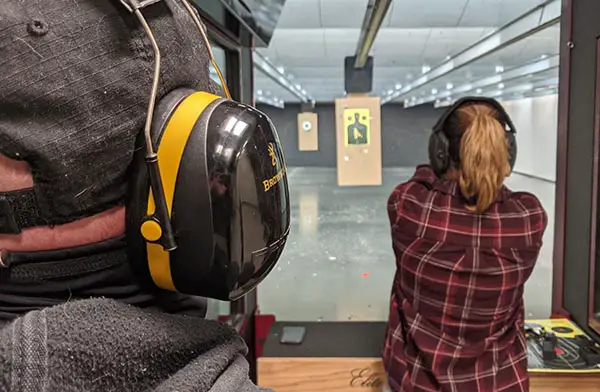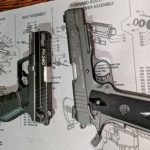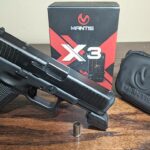If you’re preparing for the concealed carry shooting qualification and want to know what to practice, you’ve come to the right place. Today, I’m outlining the different shooting requirements including; concealed carry qualification distance, target type, and any other imposed shooting requirements. But first, let’s talk about the limitations of this article.
This document is only accurate at the time of publishing and only to the extent of information that I was able to track down. If you aren’t aware, legislation can change at the whims of your local governing body. Therefore, I highly recommend you consult your local instructor if you have specific questions about any portion of the concealed carry shooting test that is not covered.
Table of Contents
Is A Concealed Carry Shooting Test Mandatory?
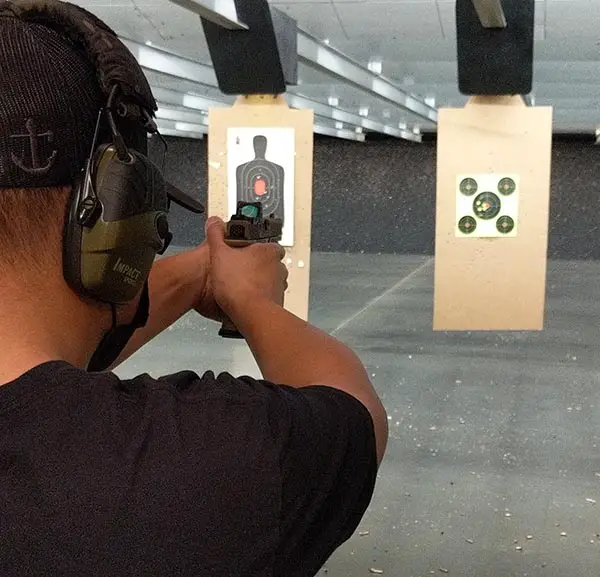
Although some states do require you to prove proficiency with a handgun, not all states require live fire exercises as part of their concealed carry qualification. Additionally, the concealed carry shooting requirements can vary greatly by quantity of ammunition fired, target type, shooting test timing, and even handgun caliber.
It is important to note that concealed carry courses with a live fire element also include classroom instruction. However, live fire instruction can vary from one teacher to another. Therefore, my primary focus is the concealed carry shooting qualification requirements.
States That DO NOT Require A Live Fire Exam
The process for obtaining a concealed carry permit differs from state to state. For instance, some states require no proof of competency with a handgun while others require both classroom and live-fire instruction.
Sometimes, live fire instruction concludes with a proof of competency exam (the shooting test). Although in-person training may not culminate in a demonstration of shooting accuracy, other actions must be performed to meet course requirements.
If your state has a “live-fire” requirement for gaining your concealed carry permit, you can expect to shoot about 100 rounds of ammunition. Below are some examples of this general rule:
- Delaware: 100 rounds
- Idaho: 98 rounds
- Michigan: 30 rounds
- South Dakota: 98 Rounds (for enhanced permit)
Concealed Carry Shooting Requirements By State
| State | Max Qual. Distance | Total Rounds Fired | Target Type | Pass % or Score |
|---|---|---|---|---|
| Alaska | 15 yds. | 20 | "Life Size Silhouette" (B-27) | 70% |
| Arkansas (Enhanced License) | 15 yds. | 50 | B-27 Silhouette | 70% |
| California | 10 yds.* | 30* | B-27 Silhouette | 80%* |
| Illinois | 10 yds. | 30 | B-27 | 70% |
| Kansas | 10 yds. | 25 | FBIQ,TQ-15, IALEFIQ | 72% |
| Kentucky | N/A | 20 | "Full-Size Silhouette" | 55% |
| Louisiana | 15 ft. | 36 | B-27 | 100% |
| Maryland | 15 yds. | 25 | B-27 (or equivalent) | 72% |
| Minnesota | 7 yds.* | 10* | B-27 * | 70%* |
| Missouri | 7 yds. | 36 | B-27 (or equivalent) | 75% |
| New Mexico | 7 yds. | 25 | 12" wide X 18" tall | Score of 72 |
| North Carolina | 7 yds. | 30 | bullseye OR silhouette | 70% |
| Rhode Island | 25 yds. | 30 | "L" target | Score of 195 |
| South Carolina | 15 yds. | 50 * | B-27 OR any standard silhouette | 70% |
| Texas | 15 yds. * | 50 * | B-27 * | 70% * |
* this data was extrapolated from course offerings or other sources but could not be directly corroborated with government documentation.
Alaska CHP Concealed Carry Shooting Test

Pistol practice target (10 in. X 10 in.) at varying shooting distances as a point of reference.
To pass the concealed carry shooting qualification exam for Alaska, you’ll need to shoot with 70% accuracy from a distance of 7 yards and 15 yards. Additionally, the exam consists of shooting ten rounds from each distance for a total of 20 shots fired. However, the target requirements are vague. Instead of a specified target type, the concealed carry shooting qualification for Alaska uses a “life size silhouette.” Additional information can be found by visiting the Alaska legislative library.
Arkansas Enhanced Permit Shooting Qualification
Arkansas has a fairly extensive course of fire for their shooting exam. Below I’ve outlined the course of fire for the Arkansas Enhanced permit shooting test, which covers 3, 7, and 15 yards. Additionally, the shooting test is performed on a standard B-27 target.
| Distance | Shots Fired | Shot Timing | Number of Repetitions |
|---|---|---|---|
| 3 yards | 1 | 2 sec. | 5 |
| 3 yards | 2 | 3 sec. | 5 |
| 3 yards | 5 | 10 sec. | 1 |
| 7 yards | 5 | 10 sec. | 1 |
| 7 yards | 2 | 4 sec. | 1 |
| 7 yards | 3 | 6 sec. | 1 |
| 7 yards | 1 | 3 sec. | 5 |
| 7 yards | 5 | 15 sec. | 1 |
| 15 yards | 2 | 6 sec. | 1 |
| 15 yards | 3 | 9 sec. | 1 |
| 15 yards | 5 | 15 sec. | 1 |
Similar to the Texas shooting test, a student can pass the examination without ever having to fire a round at the 15 yard shooting distance providing they shoot proficiently at shorter distances. However, be aware that instructors require you to pass the shooting exam in 3 tries or you have to wait 90 days before administering the qualification again. This and other useful information can be found here.
California Concealed Carry Shooting Distances
As with everything firearm related, California makes it near impossible to find appropriate information. However, in an effort to “hit” the proverbial “target” here is what I was able to track down.
According to the San Diego Sheriff’s Dept website, applicants for a CCW must fire 15 rounds during the shooting proficiency exam. Additionally, 11 of those rounds must hit the target. Finally, a total of 5 rounds must be fired from 3, 5, and 7 yards.
Contrarily, El Dorado County sheriff requires applicants to fire 30 rounds with 80% accuracy. Additionally, the shooting distances for qualification are 3, 7, and 10 yards but require a different course for fire and utilizes the B-27 target.
Therefore, you should be proficient up to 10 yards with 80% accuracy to ensure you can pass the shooting qualification in California.
Illinois Qualification Distance & Accuracy
Documentation for the Illinois concealed carry shooting test is fairly descriptive. To qualify for a concealed carry license in Illinois, you must shoot a total of 30 rounds; 10 shots from 5, 7, and 10 yards.
Additionally, Illinois requires the use of a B-27 silhouette target and shooters must shoot with 70% accuracy or better. However, the training requirements do not mention shot timing, handgun type, or caliber specifications for the shooting exam. The source of this information is the Illinois legislative library.
Kansas Live Fire Shooting Distance Requirements
Kansas is pretty lax with regard to their shooting exam requirements. However, students are still expected to hit the target with 18 of 25 rounds fired. The shooting test is conducted by firing 5 rounds at 3 yards with one hand. Next, students must fire 5 rounds at 7 yards. Additionally, exercises are repeated for two repetitions. Finally, students must shoot 5 rounds at 10 yards for two repetitions. This information was obtained from the Kansas Attorney General office.
Kentucky Shooting Qualification Requirements
If Arizona and Texas have difficult shooting exams, then Kentucky is probably one of the easiest — at least according to the statutes. Students are only required to fire 20 rounds during the live-fire portion of concealed carry training and hit the target with 11 rounds! Additionally, there is no set distance interval according to the state codes regarding acceptable training. Learn more information about training from the Kentucky legislative code.
Louisiana Live Fire Qualification Requirements
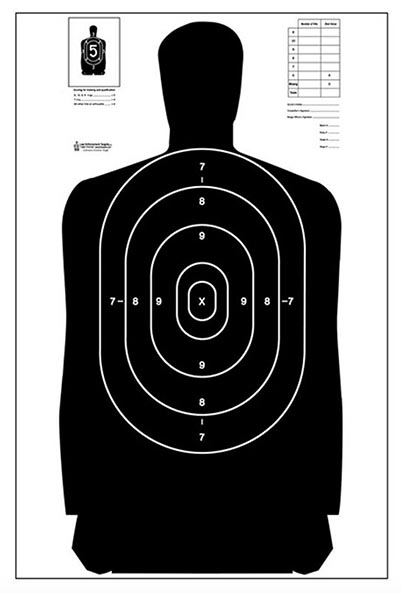
B-27 target dimensions (24 in. wide X 45 in. tall) used in shooting test.
Similar to Illinois, Louisiana has a fairly extensive list of requirements for the concealed carry shooting exam. Students must fire 12 rounds and the concealed carry distance qualification is 6, 10, and 15 feet. Thus, Louisiana exam has the shortest concealed carry qualification distance. However, there is no margin of error and 100% of the rounds must hit the target. Additionally, students must complete a reload of the handgun at each distance interval. Furthermore, Louisiana uses the B-27 target as the standard. The source of this information is the Louisiana legislative library.
Maryland Shooting Distance & Progression
Not to be outdone by other states, Maryland requires that those seeking a concealed handgun permit prove their ability to shoot with an extensive shooting test. However, at a basic level, students must shoot a total of 25 rounds at the target and must hit with 18 shots to get a passing score. Additionally, the concealed carry distance qualification is performed at 3, 5, and 7 yards using a B-27 target.
It’s worth noting that students are allowed to use two hands for each exercise. First, one round is fired from the 3 yard distance within 3 seconds. This is performed 5 times. Next, the target is moved to 5 yards and shot quantity and timing are varied. Finally, the target is moved back to 7 yards and again requires varied shot timing and quantities.
More detailed information about the shooting progression and course of fire can be found here and scrolling to the “Basic Practical Handgun Course” section.
Minnesota Concealed Carry Qualification Distance
Minnesota is unique in that it requires a “live fire” exercise but does not explicitly describe what constitutes the course of fire. However, you can find out further detail from firearmsandliberty.com who does an excellent job explaining why I used the numbers in my chart above. For their part, they describe the test as shooting at a B-27 target from a distance of 7 yards where 7 of 10 shots must hit the target.
Missouri Distance Qualification & Accuracy Requirements
The Missouri shooting test appears to mirror a self defense shooting scenario. Applicants are required to shoot from a distance of 7 yards for the Missouri shooting exam. Additionally, 15 of the 20 rounds fired must hit the B-27 silhouette target to pass.
However, there appears to be no time limit for the total shooting test or between individual shots. Additionally, it does not appear that handgun type or caliber affect the shooting exam. You can review this information and others at the Missouri Revisor of Statutes site.
New Mexico Distance Qualification & Other Requirements
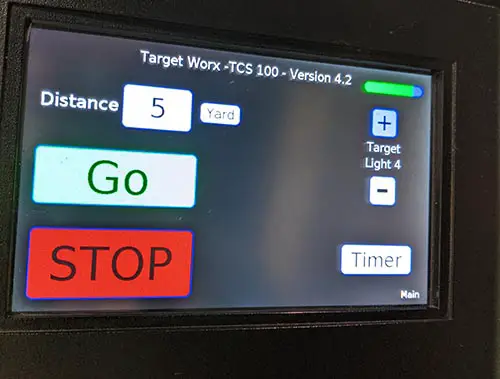
New Mexico is one of the few places, where the caliber of the gun used during an exam matters. Thus, you must qualify with a gun that uses the highest caliber round you plan to carry. Therefore, applicants for a concealed carry cannot complete the shooting test with a .22lr pistol and then carry a .45 ACP handgun. In fact, you cannot qualify by shooting smaller than .32 caliber.
Additionally, New Mexico does not rely on a standard target designation but rather sets the dimensions at 12 X 18 inches. Furthermore, the concealed carry distance qualification is perfomed at at 3 yards for 15 shots and 7 yards for 10 shots.
Points are awarded for hitting the target (4 per hit, 0 for miss). Rather than use a percentage based approach a total score of 72 must be reached to pass. Therefore, the easiest path to passing is hit the target every time at 3 yards, thus requiring you only make 3 hits at 7 yards. You can find more about the exam requirements here.
North Carolina Shooting Test Requirements
North Carolina also has some detailed requirements for their shooting test. Students must fire 30 rounds total from three different distances. Specifically, concealed carry distance qualification is conducted at 3, 5, and 7 yards. Thus, ten rounds are fired at each distance during the shooting test.
North Carolina is less specific about the type of target and only lists “bullseye or silhouette” as the type of target used. However, shooters must hit the target with 21 of the 30 rounds in order to pass.
Although, it is unclear if a passing score means hitting the target with 7 of 10 rounds at each distance OR whether simply 21 of 30 hits overall will suffice (e.g. 10 hits @ 3 yards, 9 hits @ 5 yards, and 2 hits @ 7 yards). The source of this information can be found here.
Rhode Island Shooting Test Requirements

“L” target measures 28 in. X 28 in. with a 5 in. center
Unlike other states that make finding concealed carry distance qualification and other requirements impossible, Rhode Island is up front and includes the information in the legislative code. First, applicants must complete the live-fire qualification using a handgun chambered in a caliber equal to or larger than the one they intend to carry.
Additionally, the concealed carry distance qualification is 25 yards on an Army “L” target. Specifically, the test consists of firing 30 rounds, and shooters are allotted 10 minutes per 10 rounds fired. Finally, the applicant must score a 195 out of 300 possible points
South Carolina CWP Distance Qualification
South Carolina shooting test requirements are a bit vague and difficult to track down. However, I was able to piece together some of the requirements. First, the shooting exam uses a standard silhouette target, inlcuding the aforementioned B-27 target. Additionally, the maximum distance that can be used for evaluation is 15 yards. Finally, a passing score on the shooting test is 70%.
The above information can be found via the SLED instructor packet. However, I needed to rely on the shooting requirements from a CWP course to fill out the exact progression for the shooting test.
According to the definitedefense.com website a total of 50 rounds are used during assessment. Below is their breakdown of the shooting test distances:
- 10 rounds @ 3 yards
- 10 rounds @ 5yards
- 10 rounds @ 7 yards
- 10 rounds @ 10 yards
- 5 rounds @ 12 yards
- 5 rounds @ 15 yards
Finally, although a “time limit” is referenced in the instructor packet I was unable to track down the exact numbers. However, the time limit seems to represent a “reasonable amount of time to complete the exercise.”
Texas Shooting Test Distance & Course Of Fire
Although Texas has a bit of a reputation when it comes to guns, their concealed carry exam is no joke and probably the most intense to perform. Additionally, the Texas license to carry distance qualification is only rivaled by the Arkansas Enhanced Permit shooting test. Unfortunately, I was unable to track down a code or document specifically outlining the shooting test.
However, I did do a comparison of two separate organizations offering classes to fulfill the training prerequisite. Thus, below is the breakdown:
| Distance | Shots Fired | Shot Timing | Number of Repetitions |
|---|---|---|---|
| 3 yards | 1 | 2 sec. | 5 |
| 3 yards | 2 | 3 sec. | 5 |
| 3 yards | 5 | 10 sec. | 1 |
| 7 yards | 5 | 10 sec. | 1 |
| 7 yards | 1 | 3 sec. | 5 |
| 7 yards | 2 | 4 sec. | 1 |
| 7 yards | 3 | 6 sec. | 1 |
| 7 yards | 5 | 15 sec. | 1 |
| 15 yards | 2 | 6 sec. | 1 |
| 15 yards | 3 | 9 sec. | 1 |
| 15 yards | 5 | 15 sec. | 1 |
However, you can pass without ever having to fire a single shot at the 15 yard distance if you score appropriately at the 3 and 7 yard shooting distances. Furthermore, unlike other shooting test requirements, TX requires students to shoot accurately under time constraints. Therefore, you must master sight alignment, sight picture, and recoil management to pass.
Concealed Carry Distance Qualification Practice
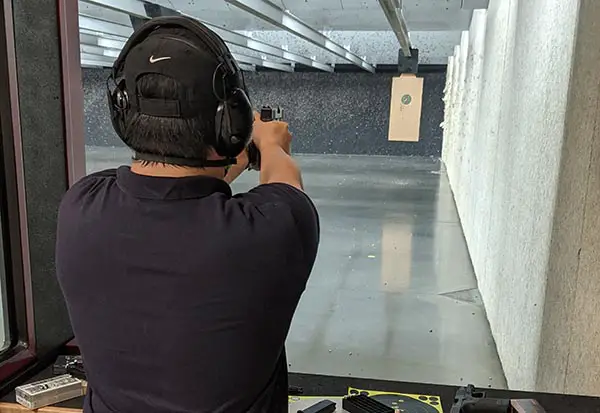
If you are new to shooting, I highly recommend you hit your local shooting range with an experience friend or family member to walk you through safe range conduct. However, if you are simply looking for a method to increase your distance accuracy to prepare for the shooting test I would look at my “beginner handgun shooting progression” article.
Because most of the exams can be passed by shooting perfectly through 7 yards, this is the best shooting distance to spend most of your practice time. Even extensive shooting tests usually allow students to pass with proficient scores prior to shooting at 15 yards. However, Rhode Island is the exception and requires you to shoot at 25 yards for the shooting qualification.
Additionally, you’ll want to practice timed shots if your state requires it as part of the testing criteria. If your state does not require this component, it is still effective for self defense practice. Finally, practice shooting at least 2 consecutive rounds at 7 yards to ensure you will pass your shooting test.
Parting Shots
If you’ve made it this far without abandoning the page I applaud you. There is a lot of information about the shooting test for each state. Although it may not be relevant to you specifically, I encourage you to challenge yourself by completing each test as a shooting exercise. If you have found this information helpful, please share with your networks. If you have additional information on states not listed please leave a comment so that others might benefit!
